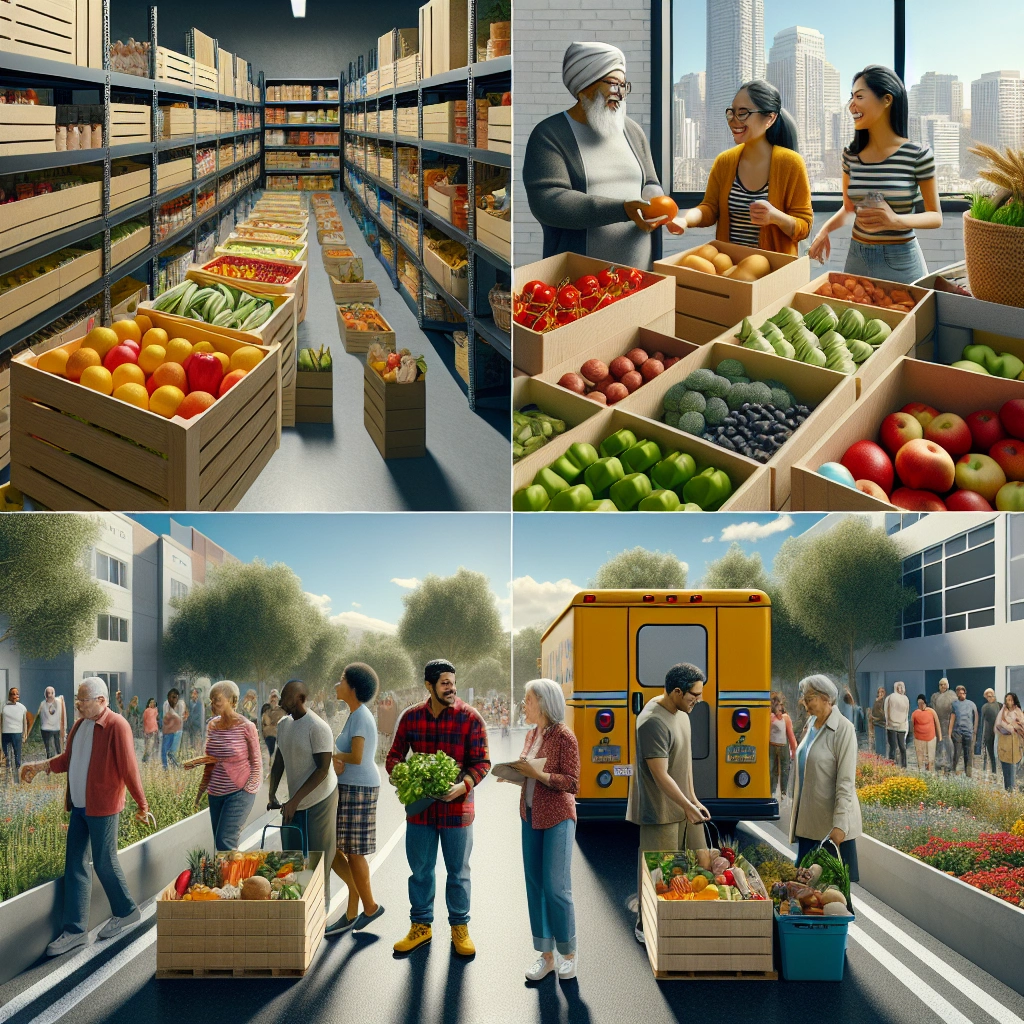

Food insecurity is defined as a lack of consistent access to enough food for every person in a household to live an active, healthy life. This can be a temporary situation for a family or can last a long time.
Food insecurity is a household-level economic and social condition of limited or uncertain access to adequate food.
Food insecurity is important to understand because it can lead to serious health issues when people have to choose between spending money on food and medicine or healthcare. It can also make it more difficult for a child to learn and grow, and can lead to difficult decisions like choosing between food and rent, bills, and transportation.
Additionally, hunger and health are deeply connected, and food insecurity can lead to Type 2 diabetes, high blood pressure, heart disease, obesity, and other chronic diseases.
Check out this Youtube video: Want to understand what food insecurity really means and how it affects people? Watch this informative video for an explanation.
The Scope of Food Insecurity
Lack of access to enough food for an active, healthy life
Food insecurity involves the struggle to access an adequate quantity and quality of food necessary for a healthy and active lifestyle. This often leads to a compromised diet, making it challenging to maintain proper nutrition, which is essential for overall well-being.
For example, families living in food deserts may have limited access to fresh produce and nutritious food options, impacting their ability to maintain a healthy diet.
Different levels of food security
Food security exists on a spectrum with varying levels of access and stability. High food security signifies consistent access to an ample and nutritious diet without any concerns or anxiety.
On the other hand, very low food security indicates severe limitations in both the quality and quantity of food intake, leading to hunger and malnutrition. Marginal and low food security fall in between, representing intermittent challenges in accessing sufficient and adequate food.
Factors contributing to food insecurity
Several factors contribute to food insecurity, including poverty, unemployment, lack of affordable housing, and chronic health conditions. Additionally, disparities in physical access to food and inadequate transportation can exacerbate food insecurity, especially in certain communities.
For instance, Hispanic households may face higher rates of food insecurity due to neighborhood conditions and limited access to nutritious food options.
| Level of Food Security | Description |
|---|---|
| High Food Security | Consistent access to an ample and nutritious diet without any concerns or anxiety |
| Marginal Food Security | Intermittent challenges in accessing sufficient and adequate food |
| Low Food Security | Reports of reduced quality, variety, or desirability of diet |
| Very Low Food Security | Severe limitations in both the quality and quantity of food intake, leading to hunger and malnutrition |
What Causes Food Insecurity
| Causes | Description |
|---|---|
| Poverty and low income | Poverty and low income are significant contributors to food insecurity as they limit people’s ability to afford sufficient and nutritious food. In many countries, the poverty rate is high, reaching as high as 76.8% in some developing nations, leading to widespread food insecurity. |
| Unemployment | Unemployment, whether structural or cyclical, can lead to food insecurity as individuals struggle to secure a reliable income to afford basic necessities, including food. Job loss can significantly impact a person’s ability to access and afford adequate nutrition. |
| High cost of living | A high cost of living, particularly in urban areas, can exacerbate food insecurity, making it challenging for individuals and families to afford enough nutritious food while also managing other essential expenses such as housing, healthcare, and education. |
| Lack of access to nutritious foods | Limited access to fresh and nutritious foods, often due to living in food deserts or remote areas, can contribute to food insecurity. Without access to a variety of healthy food options, individuals may struggle to maintain a balanced and nourishing diet, leading to food insecurity and its associated health consequences. |
Remember, people need security in the literal sense, but also figuratively when it comes to putting food on their tables. These factors play a vital role in determining the state of food security across the globe.
The Impact of Food Insecurity
Physical Health Consequences
Food insecurity has been linked to an increased risk of infectious diseases, poor oral health, and chronic conditions such as heart disease, hypertension, and obesity. It can also lead to lower nutrient intakes, cognitive problems, anemia, and birth defects. For instance, individuals living in food-insecure households are at a higher risk of developing health issues due to inadequate nutrition. This can have a drastic impact on their overall well-being and long-term health outcomes.
Mental Health Consequences
Research has shown that food insecurity is associated with a significantly higher risk of anxiety and depression. A recent CDC study revealed that food insecurity in America is linked to a 257% higher risk of anxiety and a 253% higher risk of depression. Moreover, it can contribute to psychological distress, depression, thoughts of suicide, and exacerbate symptoms of Attention Deficit Hyperactivity Disorder (ADHD). This emphasizes the profound impact of food insecurity on mental health, especially among young people.
Effects on Children’s Development
Food insecurity has been identified as a powerful stressor for families and has significant negative implications for child health and development. It affects children’s physical, social, cognitive, and behavioral development, independent of poverty. Additionally, household food insecurity has been associated with worse general health, acute and chronic health problems, and limited access to necessary healthcare. These adverse effects on children’s development underline the critical need for addressing food insecurity to ensure the well-being of the younger generation.
Social and Economic Implications
Food insecurity has far-reaching social and economic implications. It not only affects the physical and mental health of individuals and children but also contributes to broader systemic issues related to healthcare access and economic disparities.
This can lead to heightened emergency department use, forgone care, and increased financial burden on healthcare systems. Moreover, it perpetuates inequality and hinders overall societal development, making it a critical issue to address for the welfare of communities and the nation as a whole.
Identifying Food Insecurity
Food insecurity refers to the lack of consistent access to enough food for an active, healthy life. It is not just about hunger; it also encompasses the ability to obtain food and the financial resources to afford it.
Signs of food insecurity may include skipping meals, reducing portion sizes, reliance on food pantries and free meal programs, and the inability to afford a balanced diet.
Food Insecurity Around the World
Statistics on global food insecurity
According to the World Food Program, approximately 29.6% of the global population, equivalent to 2.4 billion people, did not have constant access to food, indicating moderate or severe food insecurity. Additionally, the number of people affected by hunger globally rose to as many as 828 million in 2021, highlighting the alarming increase in food insecurity.
Disparities in food access
Disparities in food access are evident in urban, rural, and low-income neighborhoods, where limited access to full-service supermarkets can be observed. Minority populations, specifically Black/African American and Hispanic/Latino, face a higher prevalence of obesity due to their restricted access to healthy foods.
This is a clear indication of the impact of food insecurity on different demographic groups.
Efforts to combat food insecurity internationally
The World Food Programme (WFP) is actively working to bring food assistance to more than 80 million people in 80 countries, demonstrating a concerted global effort to combat food insecurity. Additionally, the U. S. Government’s Global Food Security Strategy is a whole-of-government approach aimed at ending global hunger, poverty, and malnutrition.
| Country | Number of Food Export Bans | Number of Export-Limiting Measures |
|---|---|---|
| 19 | 27 | 9 |
The table above highlights the proactive measures taken by 19 countries to implement 27 food export bans and 9 export-limiting measures, contributing to the international fight against food insecurity.
Food Insecurity in the United States
Statistics on food insecurity in the U. S.
According to the latest data, 12.8 percent of U. S. households, totaling 17.0 million, experienced food insecurity at some point in 2022. This marks a significant increase from 2021, where the prevalence was 10.2 percent, equivalent to 13.5 million households.
Demographics affected by food insecurity
In 2022, 34 million people in the United States faced food insecurity, representing a concerning spike from the previous year’s 33.8 million. The highest food insecurity rates were observed in households with incomes below the poverty line and single-mother households, with 36.7 percent of families below the federal poverty line experiencing food insecurity.
Government programs and policies addressing food insecurity
To combat food insecurity, the U. S. government offers vital programs such as the Supplemental Nutrition Assistance Program (SNAP), which supports approximately 43 million Americans with access to nutritious groceries. The Biden-Harris administration has been working to strengthen this program by increasing SNAP benefits by 15%.
Historical Context of Food Insecurity
The historical events impacting food security have been varied and impactful. From natural disasters like droughts to human-made crises such as wars and economic policies, food insecurity has been a recurring issue throughout history.
For example, the Holodomor (Great Famine) induced by the Soviet Union’s economic policies resulted in 7–10 million deaths, highlighting the devastating impact of economic decisions on food security.
The evolution of policies and programs addressing food insecurity has been a crucial aspect of history. In the United States, significant attention was drawn to hunger in the 1980s, leading to the establishment and enhancement of programs and projects aimed at alleviating food insecurity, such as the President’s Task Force on Food Assistance.
This shift in policy underscored the awareness of the need for comprehensive initiatives to address food insecurity.
Lessons from history on addressing food insecurity emphasize the importance of understanding the multi-faceted causes of food insecurity and the need for proactive and holistic solutions. It is essential to recognize that addressing food insecurity requires not only the provision of food but also attention to the underlying economic and social factors contributing to this issue.
History serves as a valuable guide for recognizing the complexity of food insecurity and the necessity of comprehensive, sustainable interventions to combat it effectively.
| Historical events impacting food security | Evolution of policies and programs addressing food insecurity | Lessons from history on addressing food insecurity |
|---|---|---|
| Droughts, wars, and economic policies | Establishment of initiatives like the President’s Task Force on Food Assistance | Understanding of the multi-faceted causes and proactive solutions |
Historical Context of Food Insecurity
Myths and Misconceptions About Food Insecurity
Dispelling common myths about food insecurity
Myth #1: Only homeless people need food assistance.
Fact: In reality, food insecurity affects a broad spectrum of individuals, including working families and seniors. The face of hunger is diverse and not limited to those experiencing homelessness.
Myth #2: SNAP is a handout for the lazy.
Fact: The Supplemental Nutrition Assistance Program (SNAP) assists families facing difficult situations and plays a crucial role in supporting communities. It’s a hand up, not a handout.
Myth #3: Food insecurity is solvable through food assistance alone.
Fact: Food insecurity involves complex factors and demands multifaceted solutions. Individuals often face tough choices between buying food, paying bills, or purchasing medication.
Addressing misconceptions in public discourse
There persists an erroneous notion that hunger is not a significant issue in the United States. Contrary to this belief, almost one in eight people in the nation experience food insecurity.
It’s crucial to recognize that food insecurity does not discriminate based on homelessness, and comprehensive solutions are vital to address this pervasive issue.
Addressing Food Insecurity
Community-oriented solutions
By fostering strong collaborations with local organizations, such as food banks, food pantries, gleaning organizations, and community centers, we can create a comprehensive support system that addresses the various aspects of food insecurity. These organizations play a vital role in providing immediate relief, education, and sustainable solutions to communities in need.
Non-profit organizations working toward food security
Numerous non-profit organizations, such as Edesia and Feeding America, are dedicated to alleviating food insecurity by providing essential support, nutritious meals, and educational resources. These organizations strive to address the root causes of food insecurity and implement sustainable interventions to create long-term solutions.
Advocacy and policy changes
Policy solutions, such as the reauthorization of the Farm Bill and the commitment to end hunger in America by 2030, are crucial for addressing food insecurity at a larger scale. Additionally, advocacy efforts focus on creating meaningful changes in governmental programs like the Supplemental Nutrition Assistance Program (SNAP) and implementing ethical imperatives to reduce food insecurity and enhance access to healthy, affordable food options.
The Future of Food Insecurity
Trends and projections for food insecurity
- The 2022 prevalence of food insecurity sits at 12.8%, marking a significant increase from 2021.
- Millions of families in the U. S. are experiencing food insecurity, reversing a decade-long decline in hunger.
Innovations in addressing food insecurity
- Global food systems are facing a crisis, prompting a new roadmap from the UN and World Economic Forum to accelerate inclusive food access.
- Science, technology, and innovation play a crucial role in addressing food security, offering solutions such as genetic modification and soil improvement methods.
The potential impact of current events on food security
- COVID-19, geopolitical, and climatic events are impacting the global food system’s resilience, necessitating a comprehensive response to support food security.
- The increase in food price inflation, exceeding 5% in many low-income and middle-income countries, presents a pressing challenge to food security efforts.
The Ethical and Moral Implications of Food Insecurity
Food insecurity presents a profound moral challenge, compelling society to address the fundamental human right to food. Access to adequate and nutritious food is a basic necessity, shaping the ethical imperative to eliminate hunger and ensure food security for all.
This moral argument emphasizes the universal entitlement to live with dignity, underscoring the responsibility to address food insecurity as an ethical obligation.
Moral arguments for addressing food insecurity
The moral imperative to address food insecurity revolves around the profound obligation to manifest compassion, create opportunities, consider essential needs, and promote knowledge and empathy. Embracing these principles in food policies becomes a crucial ethical requirement, aligning with the overarching goal of fostering social justice through equitable access to food resources.
The intersection of food insecurity with social justice issues
Food insecurity and social justice become deeply intertwined, highlighting the pervasive inequities in access to healthy and nutritious food. Addressing food insecurity emerges as a critical social justice issue, acknowledging the imperative to rectify structural disparities in food access and combat exploitative labor practices.
This intersection underscores the essentiality of advancing food justice, ensuring that every individual has equitable access to the basic necessity of food for a healthy and active life.
| Initiatives for Addressing Food Insecurity |
|---|
| 1. Promoting community gardens to provide fresh produce to underserved areas |
| 2. Implementing educational programs to raise awareness about nutrition and sustainable food practices |
| 3. Advocating for equitable food distribution systems to reduce disparities in access to healthy foods |
| 4. Supporting policies that prioritize food justice and combat food insecurity |
Food insecurity remains a pressing ethical dilemma, necessitating concerted efforts to integrate moral imperatives with policies aimed at fostering social justice through equitable access to food resources.
Balancing Economic Development and Food Security
Economic implications of addressing food insecurity
Addressing food insecurity has significant economic implications. When people lack access to an adequate and nutritious food supply, it can lead to negative impacts on the economy.
These impacts include decreased work productivity, increased healthcare costs, and hindered educational attainment. Moreover, food insecurity can result in lost economic potential as individuals struggle to break free from the cycle of poverty perpetuated by malnutrition.
Finding a balance between economic growth and food access
Finding a balance between economic growth and food access is crucial for sustainable development. Economic growth is essential for improving living standards and reducing poverty, but it must not come at the expense of food access for vulnerable populations.
Policies focused on economic development should also include measures to ensure that everyone has access to sufficient, safe, and nutritious food. By finding this balance, communities can achieve not only economic prosperity but also food security for all.
Cultivating Empathy and Understanding
Developing compassion for those facing food insecurity
Developing compassion for those facing food insecurity involves understanding the challenges they face daily. We can cultivate empathy by educating ourselves about the factors contributing to food insecurity, such as financial instability, lack of access to nutritious food, and systemic inequalities.
By actively listening to the experiences of individuals impacted by food insecurity, we can gain a better understanding of their struggles and offer genuine support.
How to support individuals and communities experiencing food insecurity
Supporting individuals and communities experiencing food insecurity starts with taking tangible actions. Volunteering at local food banks, donating non-perishable items, and advocating for policies that address the root causes of food insecurity are effective ways to make a meaningful impact.
Additionally, fostering collaboration with mutual aid groups and engaging in initiatives that promote food justice can contribute to creating sustainable solutions for those in need.
Education and Advocacy
The role of education in addressing food insecurity
Education plays an essential role in addressing food insecurity by promoting awareness, imparting essential skills, and fostering sustainable solutions. Through education, individuals and communities can learn about nutrition, effective budgeting for food, and innovative farming techniques.
By integrating food security concepts into school curriculums and community programs, we can empower people to make informed decisions that positively impact their access to nutritious meals. Additionally, education also aids in raising awareness about systemic issues that contribute to food insecurity, leading to the development of advocacy initiatives and policy changes.
Advocacy techniques for those passionate about food security
Passionate advocates for food security can leverage various techniques to influence change, such as engaging with policymakers, organizing grassroots movements, and employing social media campaigns to raise public awareness. By collaborating with local organizations and participating in community events, advocates can amplify their voices and garner support for food security initiatives.
Moreover, utilizing compelling storytelling, factual data, and impactful visuals can effectively convey the urgency of addressing food insecurity, catalyzing collective action and driving meaningful change.
Recommended Amazon Products for Addressing Food Insecurity
Here’s a curated list of products that can help you address food insecurity with ease. These recommendations are based on the importance of understanding food insecurity, identifying food insecurity, and community-oriented solutions.
Product: Large Capacity Food Storage Containers
These large capacity food storage containers are perfect for storing bulk food items, which can be incredibly helpful for food banks and community organizations addressing food insecurity. The airtight seals ensure food stays fresh, and the clear design makes it easy to see the contents at a glance.
| Pros | Cons |
|---|---|
| Airtight seals maintain freshness | May be too large for individual households Clear design for easy visibility |
Product: Portable Countertop Water Filter
Access to clean drinking water is a crucial aspect of addressing food insecurity. This portable countertop water filter can easily provide clean and safe drinking water for individuals and families in need.
It’s easy to install and requires minimal maintenance.
| Pros | Cons |
|---|---|
| Provides clean drinking water | Filter replacements may add to long-term cost Easy to install and use |
Product: Nutritional Drinks (e.g. Ensure)
Nutritional drinks such as Ensure can provide essential nutrients for individuals who may not have access to balanced meals. These drinks are a quick and convenient way to ensure people get the nutrition they need.
| Pros | Cons |
|---|---|
| Convenient source of essential nutrients | Higher cost compared to whole foods Long shelf life for storage |
Product: Non-perishable Food Kits
Non-perishable food kits, such as those containing canned goods, grains, and dried fruits, are essential for addressing immediate needs during times of food insecurity. These kits provide a variety of shelf-stable, nutritious food items.
| Pros | Cons |
|---|---|
| Provides immediate food assistance | May lack fresh produce and proteins Shelf-stable for long-term storage |
Product: Gardening Starter Kit
For long-term solutions, a gardening starter kit can empower individuals and communities to grow their own food, effectively addressing food insecurity at the root. This kit typically includes seeds, planting containers, and essential gardening tools.
| Pros | Cons |
|---|---|
| Encourages self-sustainability through food production | Requires time and knowledge for successful gardening Promotes a sense of community and collaboration |
Top Recommended Product for Addressing Food Insecurity
If you’re looking for the best solution for addressing food insecurity, we highly recommend Large Capacity Food Storage Containers. Here’s why:
These large capacity food storage containers are versatile, practical, and essential for organizations and communities aiming to address food insecurity. They provide a way to store, organize, and distribute large quantities of food effectively, ultimately helping to ensure that individuals and families have access to the resources they need.
Ready to make a meaningful impact in addressing food insecurity? Check out Large Capacity Food Storage Containers today for the best results!


Conclusion
Food insecurity refers to the limited or uncertain access to enough nutritious food for a healthy and active life. It can manifest in various forms, such as the inability to afford food, lack of transportation to buy groceries, or living in an area with limited access to fresh produce and other essential food items.
Furthermore, food insecurity can have serious consequences on an individual’s physical and mental well-being. It can lead to malnutrition, chronic health conditions, and increased stress and anxiety.
Additionally, children experiencing food insecurity may struggle with cognitive development, academic performance, and social interactions.
Addressing food insecurity requires a multi-faceted approach, including improving access to affordable and nutritious food, increasing incomes, and strengthening community support systems. By working together to address the root causes of food insecurity, we can make significant progress in ensuring that everyone has reliable access to the food they need to thrive.
















